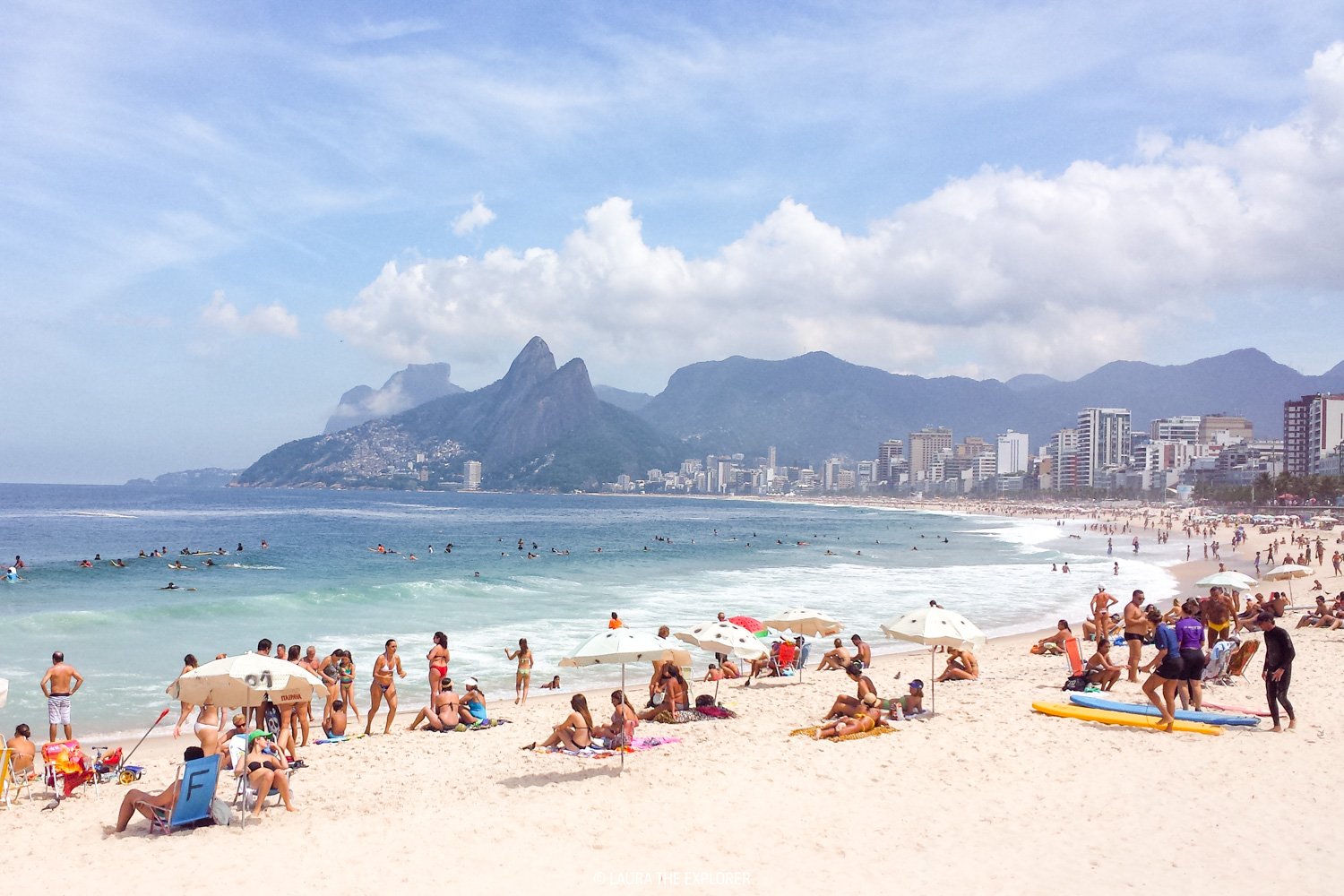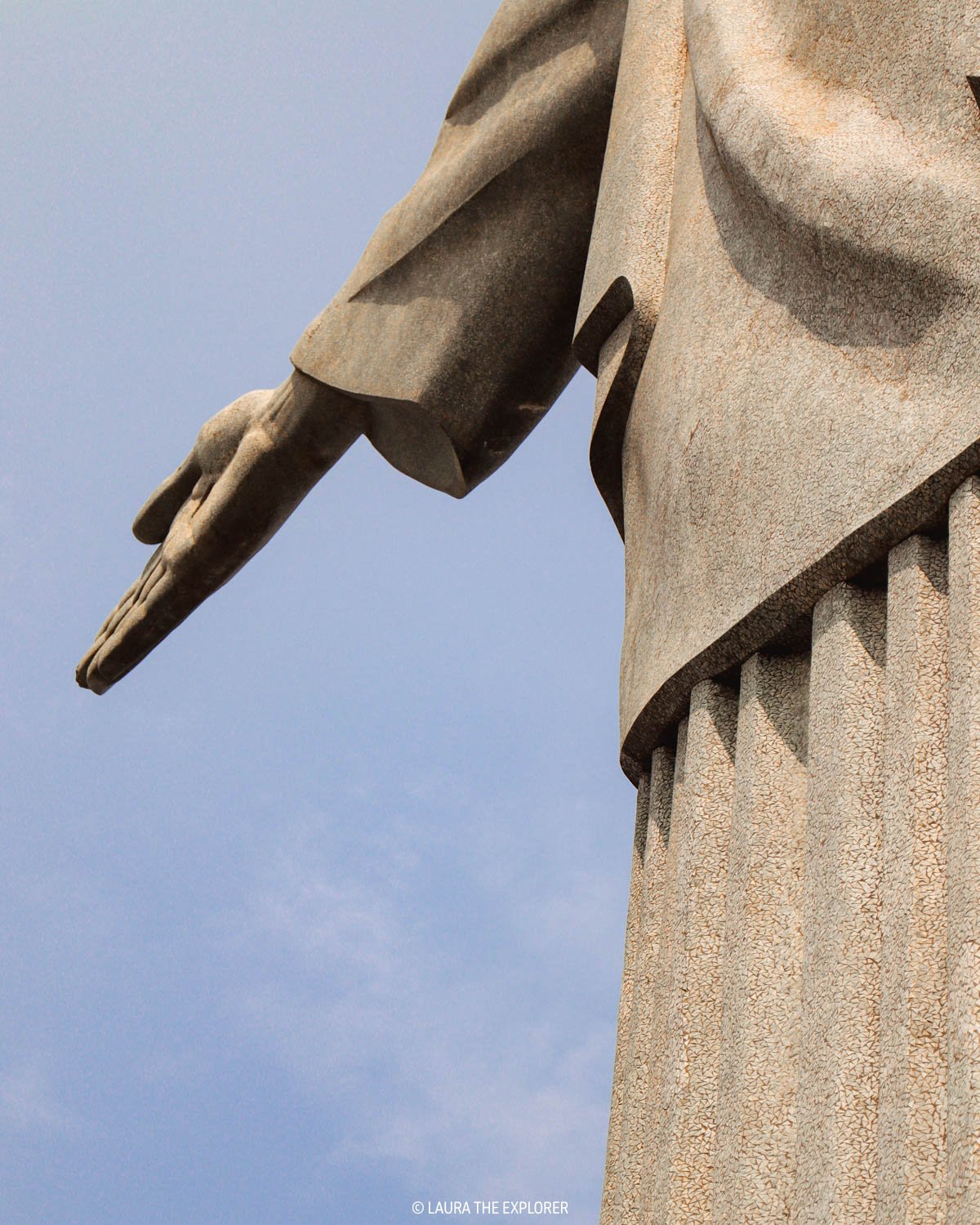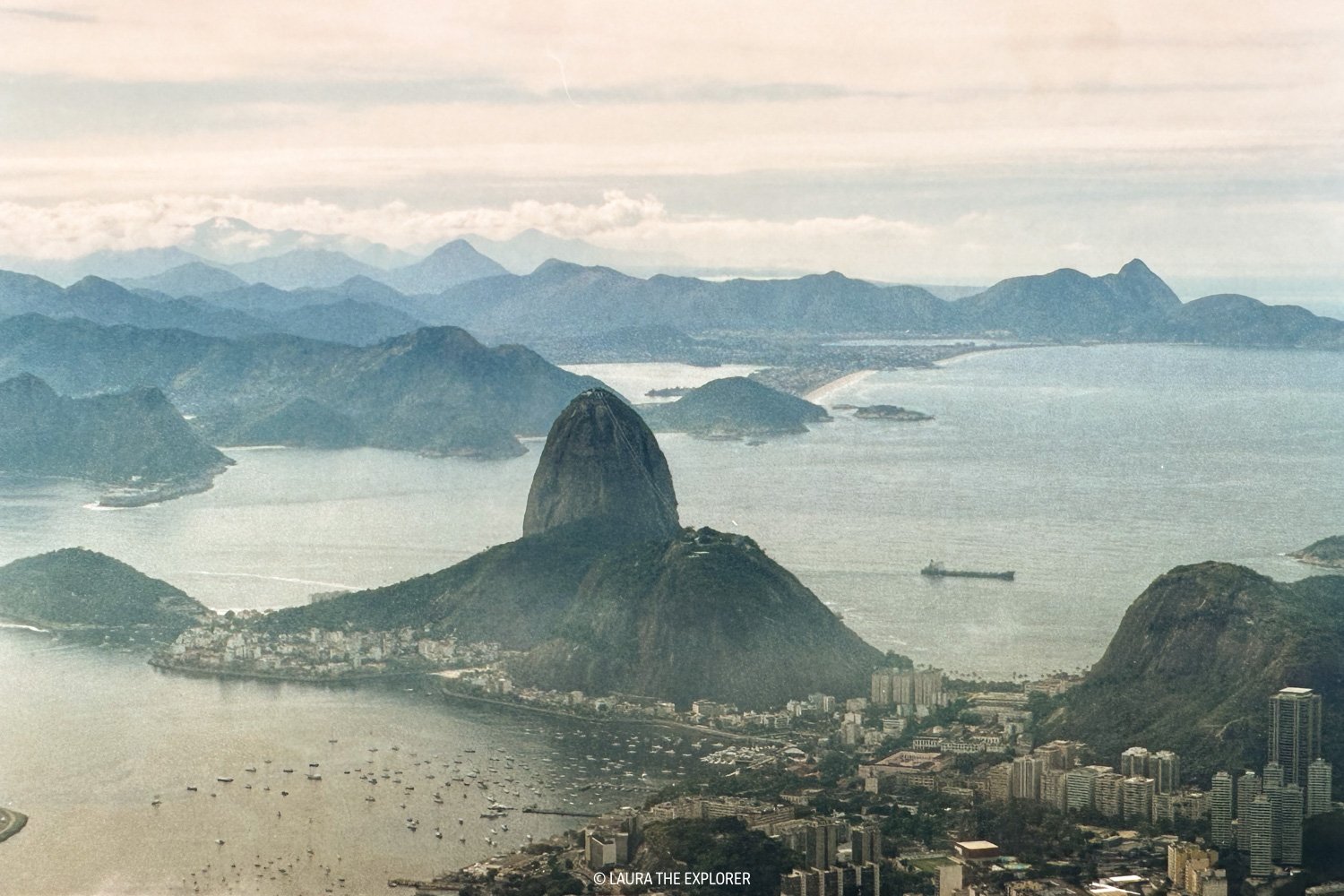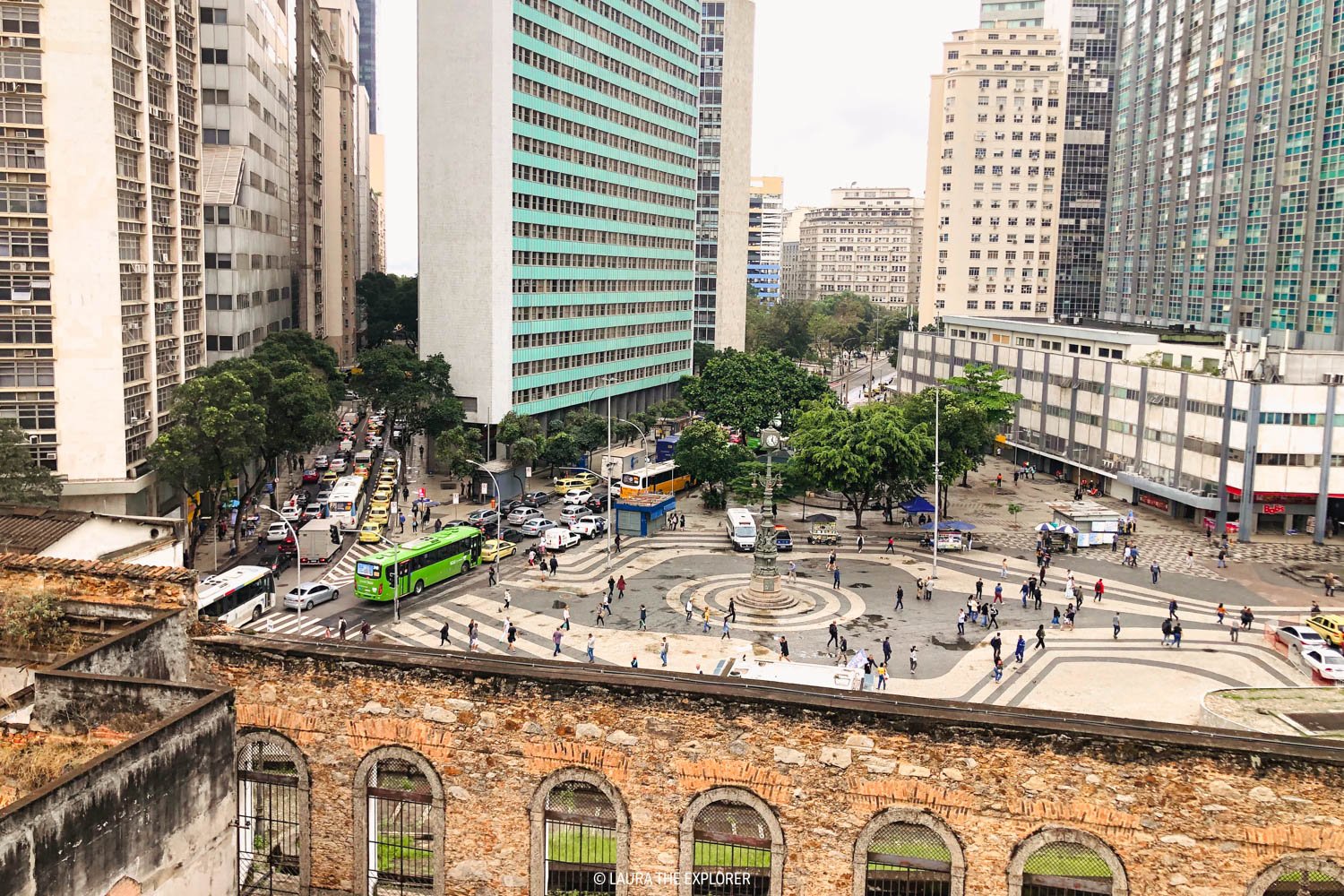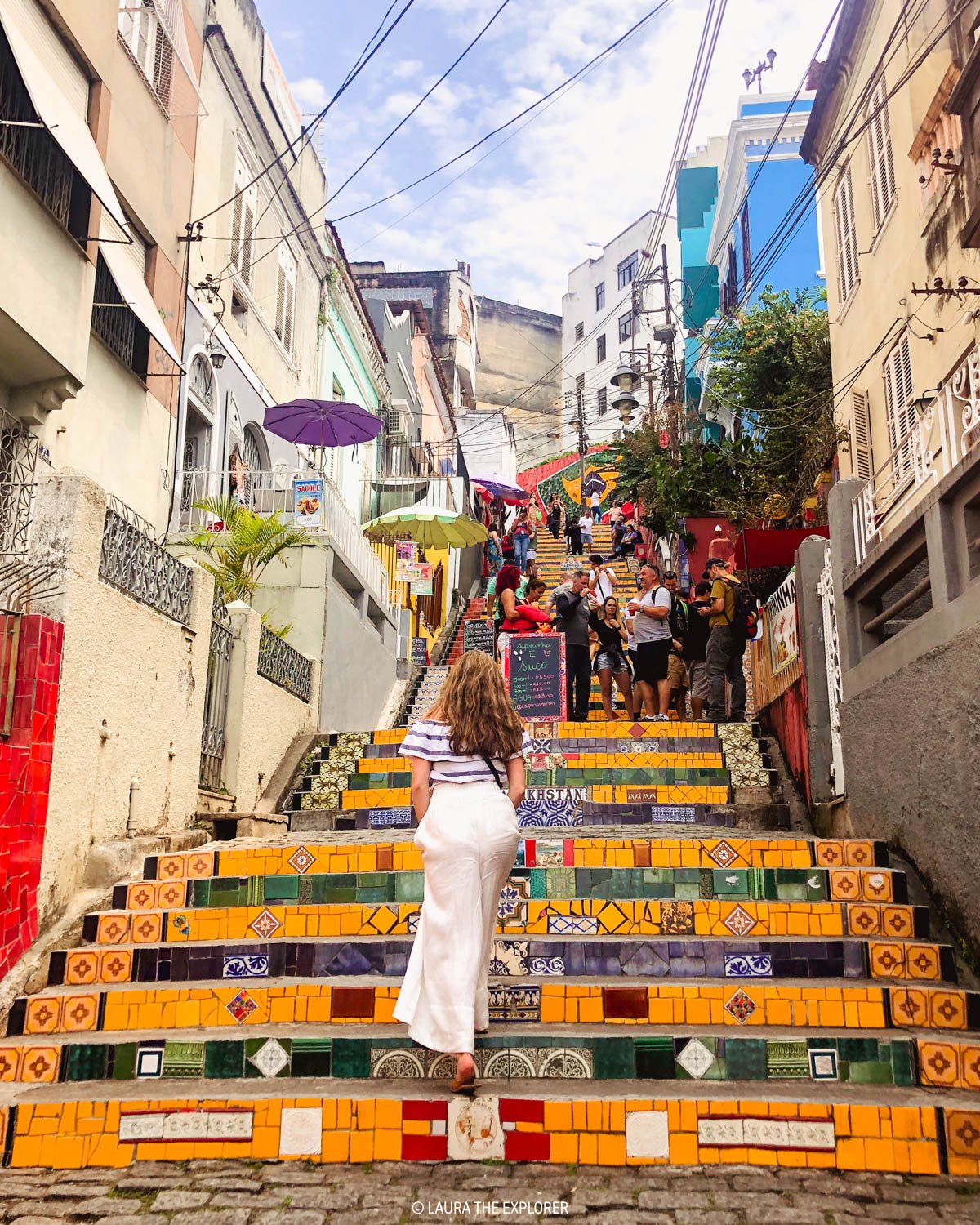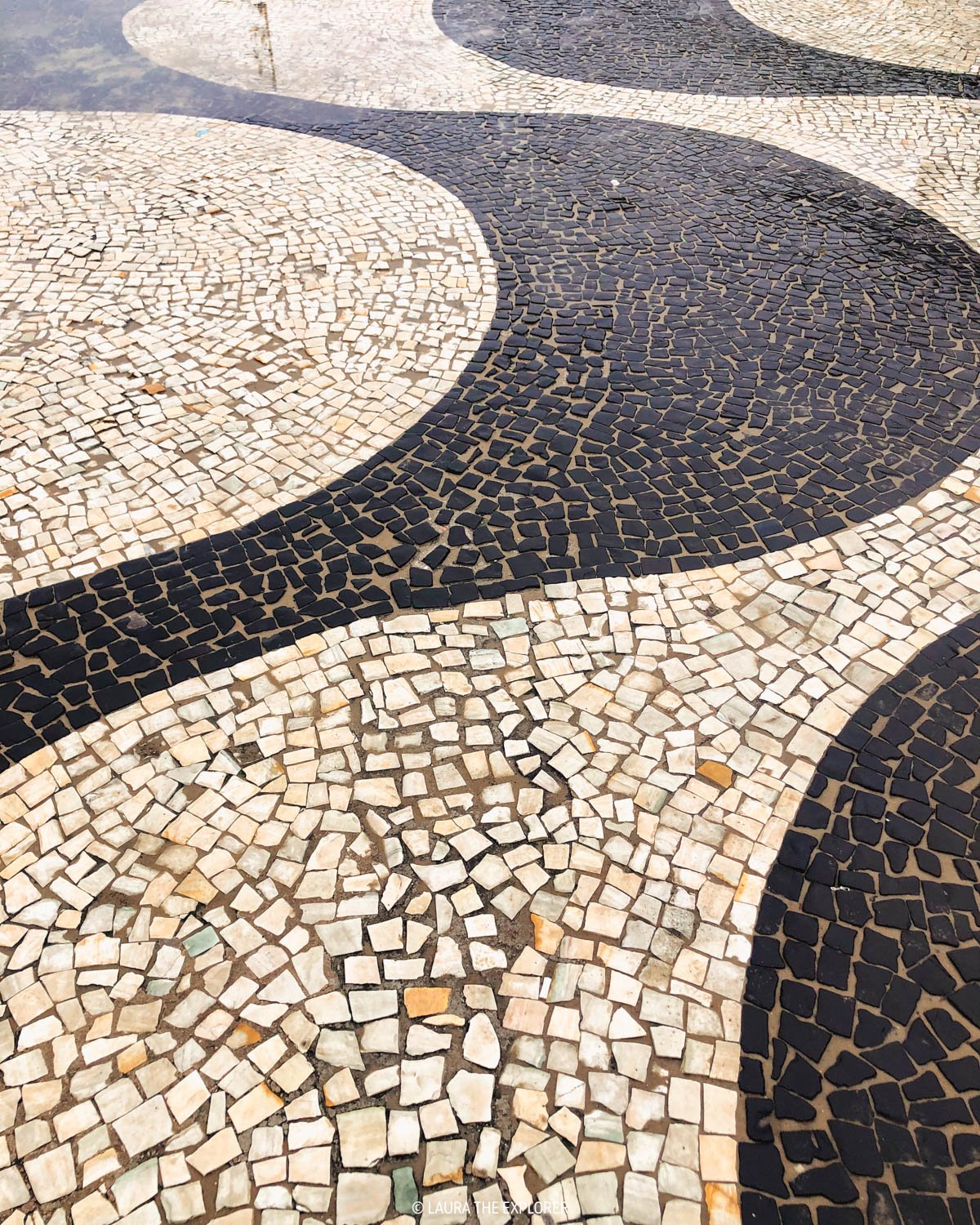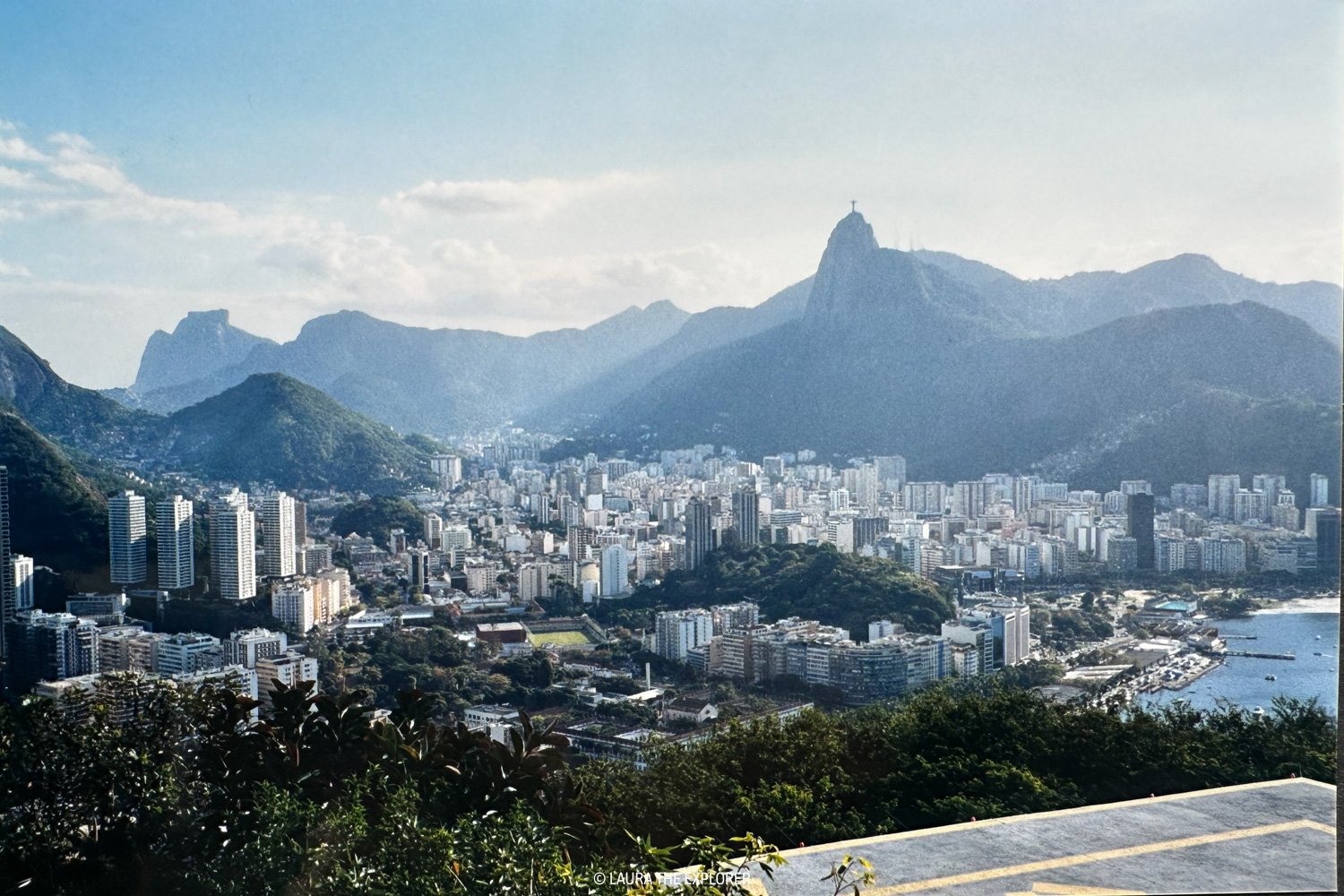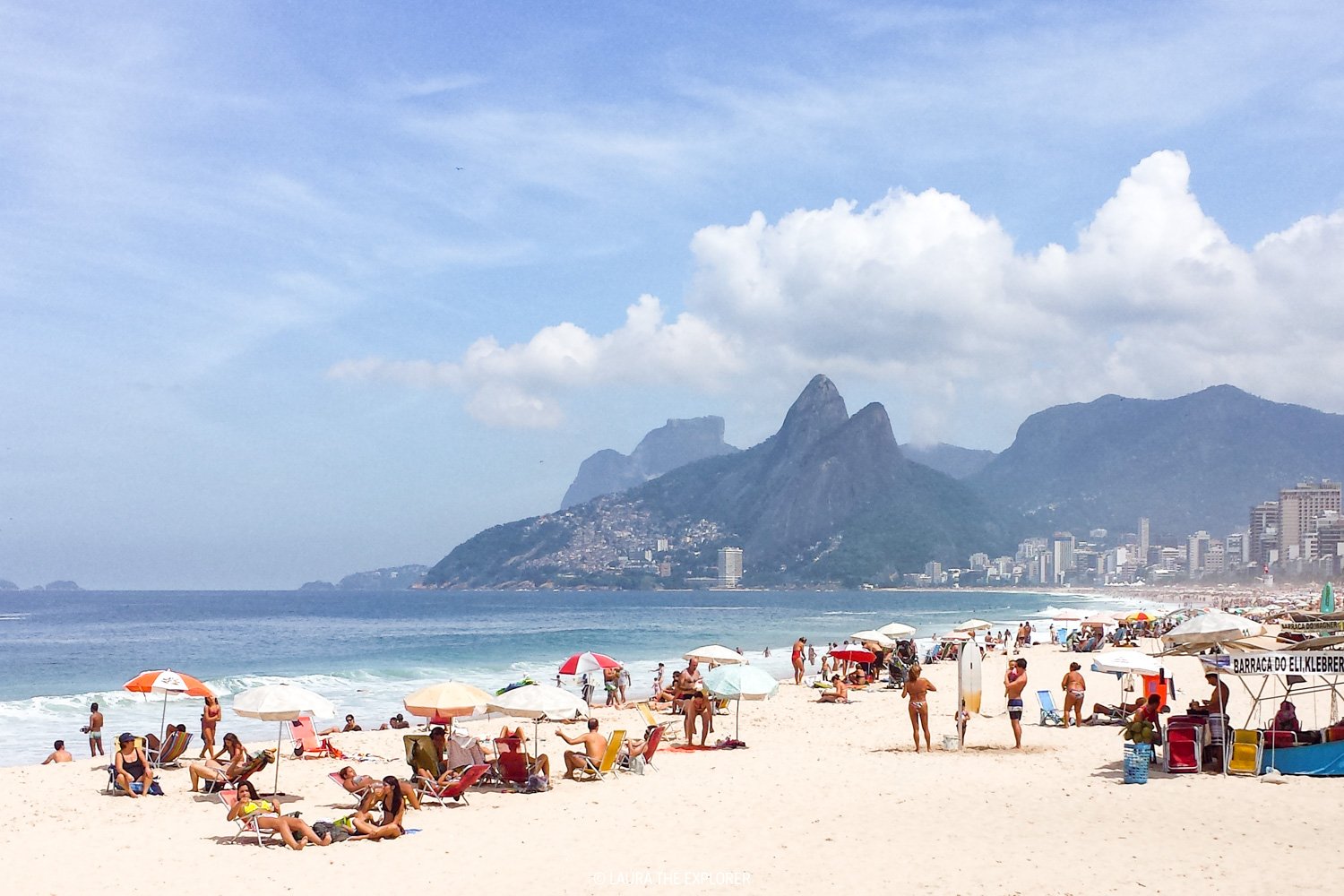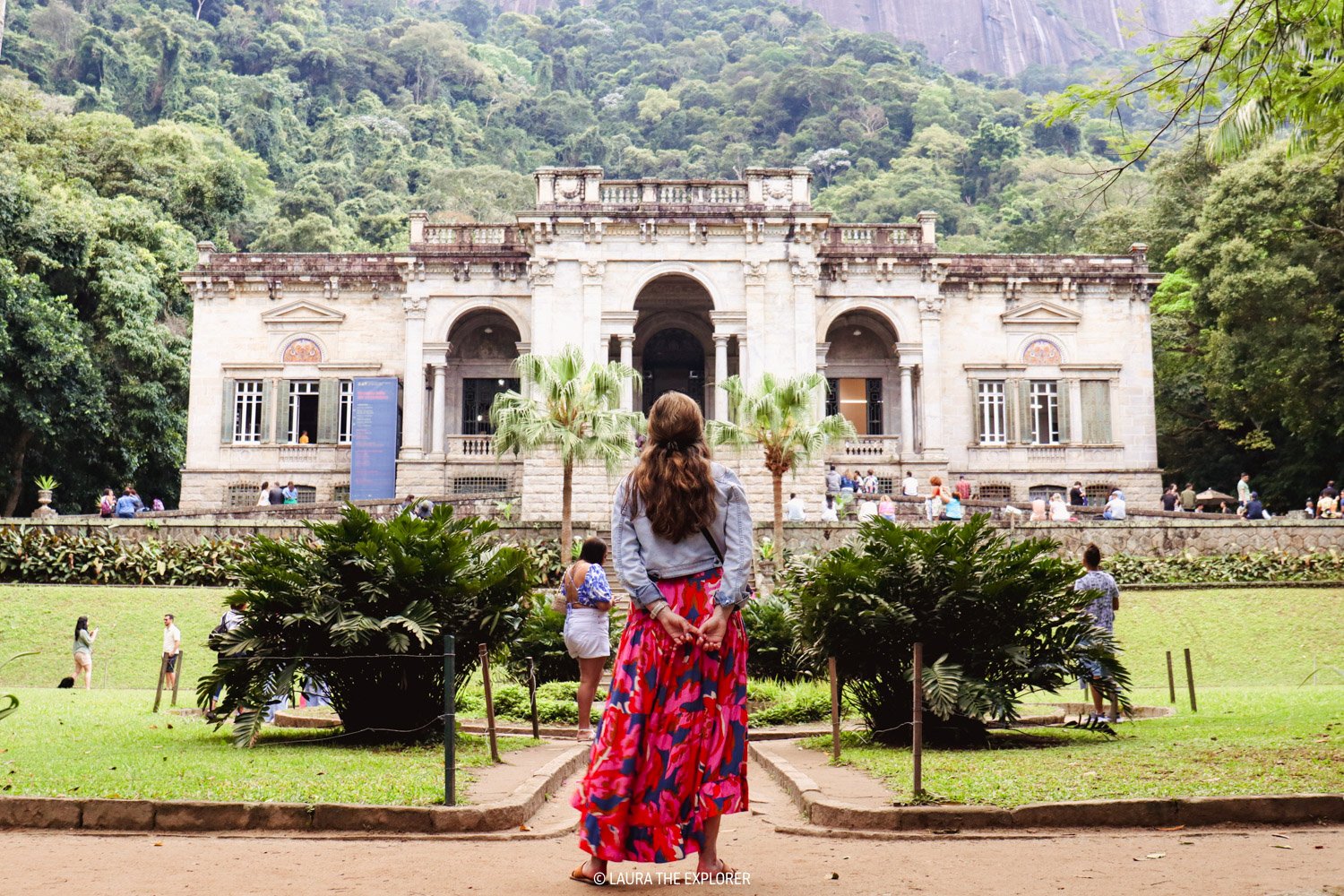The Ultimate Rio de Janeiro Itinerary + Travel Guide
In Brazil, Rio de Janeiro is known as the cidade maravilhosa (wonderful city), and I completely agree.
From the imposing granite peaks of Corcovado and Sugar Loaf Mountain, down to the white sandy beaches of Copacabana and Ipanema, Rio de Janeiro will ignite all your senses. The city truly feels alive with the beat of samba drums, the sip of a perfect caipirinha, the aroma of bolinhos de bacalhau, a glimpse of monkeys dancing in the tropical trees, and the sensation of that salty, sticky beach air.
Rio is a city that beats to its own drum, and no other major world city has the rhythm and character that Rio does.
This Rio de Janeiro itinerary and guide will really set you up for an incredible trip to Rio de Janeiro, one of my favourite cities in the world. Featuring tips on all the main attractions, along with a few hidden gems, it contains all the best places that I’ve discovered during my four visits to this fascinating, beautiful city.
Saúde!
A quick heads up: This post may contain affiliate links.
I only ever recommend products or services that I use (and love!) personally. You won’t pay anything extra if you make a purchase through one of these links, but we’ll get a small commission which helps keep the blog running.
Thanks for your support!
THE ULTIMATE RIO DE JANEIRO TRAVEL GUIDE
ARRIVING | at the two main airports
GETTING AROUND | on public transport
3 DAY ITINERARY | Christ the Redeemer, Sugar Loaf Mountain and beyond
EXTRA DAYS | if you have more time
SAFETY | how to say safe in Rio
PACKING | what to pack for Rio de Janeiro
ARRIVING IN RIO
First things first.
BY AIR
When arriving into Rio de Janeiro by air, there are two different airports that you could arrive into, Galeão – Antonio Carlos Jobim International Airport or Santos Dumont Airport.
GALEÃO INTERNATIONAL AIRPORT (GIG)
Galeão, Rio de Janeiro’s international airport, is located on an island to the north of the city center and is the airport you will arrive into on any international flight, along with many domestic flights too. Far less common as an arrival destination in comparison with the major international arrival city of Sao Paulo, it’s therefore far less busy and chaotic than Guarulhos. The main thing to note about Galeão is that it sits a little outside of the city - at least from the areas predominately visited by tourists.
BY UBER/TAXI:
The airport is most easily accessed by Uber or taxi, and relative to major cities around the world, Uber’s are really cheap for the distance travelled.
A ride between Galeão and the Zona Sul (Copacabana, Ipanema etc) takes approximately an hour, though can vary a lot with Rio’s notorious traffic at rush hour. Expect to pay around R$50 (US$10 / NZ$17) for an Uber journey (current as of Sep 2022), which run officially from the airport, are in constant supply and have a dedicated pick up point.
Taxis are 2-3x the Uber price, but can be arranged for a set price from one of the booths inside the arrivals hall. I wouldn’t go with one of the touts holding a sign as you walk out of arrivals, as they are known to be unreliable.
BY AIRPORT BUS:
There are dedicated airport buses from Galeão to various locations in Rio de Janeiro, which are cheaper than taxi/Uber and more direct than other public transport.
The schedule can be found on the Galeão website and the cost is R$18.85 (US$3.50 / NZ$6.50, price current Sep 2022) per person. Tickets can be purchased in cash from the driver, or with a RioCard (more details on that below) which will add R$3 for the initial purchase of the card.
BY BRT & METRO:
Getting between Galeão and the Zona Sul on general public transport is a little more difficult as there is no direct route, however it is technically the cheapest way of getting into the city.
BRTs (Buses that runs in a dedicated express lane) from Galeão on the Transcarioca Route intersect with Vicente De Carvalho metro station, from where the metro can be taken through to the Zona Sul or other tourist locations. There are two BRT stations at Galeão (head to either), from where you will need to buy a RioCard to use the BRT network (more details on that below). The cost is R$6.50 (US$1.50 / NZ$2.30, price current Sep 2022) for a combined BRT/Metro ticket.
This public transport option should really only be used by seasoned travelers who are comfortable working out the quirks of a foreign transport system after a long international flight.
TIP: Unless you’re on a very tight budget, I’d recommend the ease of Uber for getting to and from Galeão Airport.
Pão de Açúcar (Sugar Loaf Mountain) shot on film
SANTOS DUMONT AIRPORT (SDU)
In contrast to Galeão, Santos Dumont Airport is conveniently located right next to the city center with great transport options and is a quick trip to the main tourist destinations. It’s a domestic airport, serving destinations all over Brazil.
TIP: If you’re flying into Santos Dumont, book a window seat on the right side of the plane, and you’ll get some awesome views of the city as you come in to land!
BY UBER/TAXI:
Thanks to it’s location right on the edge of downtown Rio, it’s a quick Uber ride to any of the central and southern Rio de Janeiro neighbourhoods. Once you enter into the main arrivals hall, follow the clear Uber signage down to the Bossa Nova Shopping Mall (attached to the airport) where there is a dedicated Uber waiting area (Uber Lounge), complete with seating. To get to Copacabana, expect to pay around R$30 (US$6 / NZ$10, price current Sep 2022), and takes about half an hour depending on Rio’s traffic.
Uber is definitely the easiest way to go, but if it’s not an option due to lack of phone data, taxis are plentiful at Santos Dumont. Head to one of the taxi booths called ‘Taxi Credenciado’ within the arrivals hall to arrange a car at a set price. Expect to pay 2-3x the price of an Uber for an official taxi.
BY LIGHT RAIL:
Santos Dumont is also well connected by public transport, with a VTL (Light Rail) stop called Santos Dumont situated right outside the airport. If heading to the Zona Sul, take the VLT two stops to Cinelândia where it’s a quick transfer down to the metro station of the same name. The VLT from Santos Dumont to Cinelândia only takes 5 minutes, then the metro from Cinelândia to Copacabana is only 15 minutes. Allowing for transfer time, it’s only about a half an hour journey to get to Copacabana.
To use the VLT you’ll need a RioCard which can be purchased from the dedicated machines inside the arrivals hall. There’s no combined ticket for the VLT and metro, so it will cost R$3.80 for the VLT, R$6.50 for the metro, and R$3.00 if you need to purchase a RioCard, for a total of R$13.30 (US$2.50 / NZ$4.00).
Cristo Redentor (Christ the Redeemer Statue) watches over Rio at night
BY BUS (COACH)
Buses arrive and depart from the Novo Rio Bus Terminal to destinations across Brazil.
Booking buses in Brazil used to be quite difficult, requiring physically visiting the bus station is advance to secure tickets, but nowadays most bus lines offer reservations online. It can still be tricky for foreigners however, as many online systems require a Brazilian CPF number (similar to a USA social security number) in order to complete an online booking.
I personally find the easiest way to avoid needing a CPF to book Brazilian buses is to use BusBud.
Given Brazil’s size, there a lot of companies servicing different regions of the country, so Busbud was also helpful for finding all the various Brazilian bus lines that I needed.
Arriving into Rio is similar to the Santos Dumont Airport above, as the bus station is also served by the VTL (Light Rail) with a stop called Rodoviária (portuguese for bus station), situated right outside the bus terminal.
From here to the Zona Sul, take the VLT Line 1 for twelve stops to Cinelândia where it’s a quick transfer down to the metro station of the same name. The VLT from Rodoviária to Cinelândia only takes 15 minutes, then the metro from Cinelândia to Copacabana is only 15 minutes. Allowing for transfer time, it’s only a little over a half an hour journey to get to Copacabana from the main bus station.
GETTING AROUND RIO DE JANEIRO ON PUBLIC TRANSPORT
Walking along some of Rio’s beaches is a must and Ubers are cheap and plentiful, but at some point, public transport is going to be your best option to get around Rio de Janeiro.
Most of the main sights aren’t within walking distance of each other and Rio has some pretty notorious rush hour traffic so it’s definitely worthwhile figuring out the public transport as a quick and easy way to get around the city.
It can be a bit overwhelming trying to figure out public transport in a foreign city, especially when not everything is in your native language and everyone else is in a rush to get somewhere, but fear not, public transport in Rio is plentiful and pretty easy to figure out.
The Santa Teresa neighbourhood of Rio de Janeiro
» PUBLIC TRANSPORT TICKETS
The easiest way to get around Rio on public transport is using a RioCard. The RioCard is the equivalent of London’s Oyster, Sydney’s Opal and New York’s OMNY.
The cards can be purchased at self-service machines and counters within metro stations, at airports, at convenience stores and online. The easiest place to buy the card and/or top-up is either at the airport on arrival and at a metro station.
RioCards can be used on the Metro, BRT (Rapid Transit Bus), Bus, Van, Intercity Bus, VTL, Train and Ferry. Details on each of those down below!
RIOCARD COSTS
RioCard initial card cost: R$3 (US$0.60 / NZ$0.95)
Minimum top-up on purchase of the card: R$4.05 (US$0.80 / NZ$1.25)
Single Bus, Van or BRT Trip: R$4.05
Single VLT Trip: R$3.80
Single Metro Trip: R$6.50
Single Train Trip: R$5.00
Single Ferry Trip: R$7.70
The best thing about the RioCard however is when you combine two modes of transport into one journey. For example, getting from Copacabana beach to Christ the Redeemer, you’ll likely take a metro and a bus, so your RioCard will combine these two stages into one combined fare:
Bus+Bus, Bus+VLT or Bus+BRT: R$4.05
Metro+Bus or Metro+Van: R$7.40
Train+Bus or Train+Metro: R$8.55
Metro+BRT: R$6.50
Ferry+Bus, Ferry+VLT, Ferry+Metro, Ferry+Train: $R8.55
All prices current as of October 2022.
TIPS FOR BUYING A RIOCARD
The self-service machines at the metro stations only accept cash and do not give change - so come prepared with appropriate (non-torn) notes/bills.
We never saw the tickets counters open in the metro station, so don’t rely on using these.
There are different types of self-service machines in the metro stations, some are purely for metro tickets (MetroRio), not for the RioCard (which can be used on different modes of transport) so be sure to look for the RioCard signs.
Sometimes the self-services machines are up on the street, sometimes they’re down in the main concourse. If you need help finding one ask an attendant for “He-oh card” and they’ll point you in the right direction (in Portuguese, an ‘r’ at the start of a word is pronounced like an ‘h’).
You’ll only be able to top up online/in the app if you have a Brazilian CPF (tax) code, so if you’re just visiting, don’t rely on the RioCard app.
If you want details from the official RioCard website before you go, be aware that you might not be able to access the page! For some reason, at home in New Zealand the site simply does not load for me, despite coming up in google search results and trying to access it on various services providers.(A similar thing happens on other official government Brazilian websites, for example the Parque Lage tickets mentioned down below). I’m curious to know if you can access the site from your home country - drop me a message in the comments down below!
Take the train up Corcovado mountain
» RIO BY METRO
If you’re going to any public transport in Rio, it’s most likely to be the metro. By far the easiest way to get from the beaches to the city centre, the metro is much faster than anything above ground at rush hour.
Some good metro stops to remember, which appear in my itinerary below, are:
Nossa Senhora da Paz / Ipanema: there are two Ipanema stations and one Leblon station, but this is the most central for shopping, restaurants and beaches.
Siqueira Campos / Copacabana: there are two Copacabana stations, but this is the most central.
Botafogo / Coca-Cola: best place to change to buses to Sugar Loaf Mountain and Parque Lage. Interesting fact, naming rights to this station were sold to avoid a financial crisis in the metro company!
Largo do Machado: best place to change to a bus to Christ the Redeemer (Trem do Corcovado station).
Carioca / Centro: best place to access the historical centre of Rio, the Santa Teresa tram, and switch to the VLT.
Central: not to be confused with Centro, Central is also the name of the connected main train station for lines to further out suburbs in the North and West of the city.
The busy town square outside Carioca metro station
TIPS FOR USING THE METRO
You’ll need to pass through an access gate to get to the platform Some of the gates are for RioCard passes, some are for metro-only passes. Look for the pink RioCard signage.
We never found the trains overly packed and there was a lot of security around. Nevertheless, keep very aware of your belongings while in the metro stations and on the metro carriages. You’ll find most locals keep their bags tucked under their arms. Never put your backpack or daybag down on the ground.
Stations contain lots of clear signage indicating direction of travel. Station names are also clearly labelled so it should be easy identify the station you’ve arrived in to.
Try and find out the best station exit for your route before going underground (on GoogleMaps etc), as there are usually multiple exits for each station.
» RIO BY VLT
VLT stands for Veículo Leve sobre Trilhos, which translates to Light Rail.
Travelling by VLT is an easy way to get around the Centro area of Rio, or if you’re arriving into Santos Dumont Airport, or at the main inter-city bus terminal Rodoviária Novo Rio. It follow the cities streets and is super easy to jump on board.
TIPS FOR USING THE VLT
Don’t forget to tag on when you board (there are contactless terminals inside the carriages). There are often attendants patrolling and checking you’ve tagged on.
Tagging off when you exit the VLT is not required.
RioCard self-service machines can be found at VLT stations.
The VLT tracks pass right outside this craft brewery near Praça Mauá
» RIO BY ‘SURFACE METRO’
There are some express bus lines in Rio da Janeiro that are referred to as Metrô na Superfície, which translates to Metro on the Surface.
These express bus routes are intended to be extensions on the metro lines, and run between:
Botafogo/Coca-Cola and Gávea (a suburb next to Leblon): ideal for getting to Parque Lage (use Hospital da Lagoa stop) or the Botanical Gardens (use Jardim Botânico stop).
Antero de Quental (Leblon) and Gávea: not the most frequented route by tourists, but it completes the loop around Rodrigo de Freitas Lagoon.
TIPS FOR USING THE SURFACE METRO
For costs, a trip on the Surface Metro is charged as a metro trip rather than a bus trip, so use the metro single trip/combined trip for pricing.
The Surface Metro buses should stop at every stop, similar to a metro train, so it’s easier to know when to get on and off.
» RIO BY BUS
There are hundreds of bus routes that cover the city of Rio, so it won’t be hard to find one to take you where you need to go. There’s also generally at least a few different options, and even more so on the main arterial routes, where buses are constantly flying past.
TIPS FOR USING BUSES
Buses need to be flagged down, or they’ll simply fly past.
You’ll need to swipe your RioCard before passing through the barrier into the seats.
Rio bus drivers can be a little enthusiastic, expect some sharp braking ;)
Bus quality varies a lot, but don’t expect air conditioning.
A bus may be scheduled to arrive every 10 minutes, but you’re more likely to go half an hour without one and then three come at once. It’s good to have a couple of options in mind. We found that popping our route in Google Maps would give multiple bus options, and we just jumped on the first one that came by.
Keep Google Maps open to track your route and know where to jump off.
Looking for where to eat the best food in Rio de Janeiro?
Search no more than my comprehensive list of the best places to eat in Rio!
THE ULTIMATE 3 DAY RIO DE JANEIRO ITINERARY
MAP OF PLACES TO GO IN RIO DE JANEIRO
DAY 1 - CRISTO, COSME VELHO & SANTA TERESA
In a nutshell: Christ the Redeemer Statue, Cosme Velho neighbourhood, Santa Teresa Tram and the Selarón Steps.
For your first full day in Rio explore the neighbourhoods of Cosme Velho and Santa Teresa, two of the oldest neighbourhoods in Rio de Janeiro that are jam packed with some of the most iconic sights of the city.
» CHRIST THE REDEEMER
It’s the sight the most quickly comes to mind when you think of Rio de Janeiro and this incredible feat of engineering draws millions of visitors every year. Is there anyone who goes to Rio and doesn’t have a photo of themselves, arms spread open, in front of the Big Jesus statue?
Perched up in the clouds, surrounded by dense jungle and looking down on the city below, standing atop the granite peak really does create a sense of magic.
Look up close and see the soapstone tiles that form Cristo Redentor (Christ the Redeemer)
TIPS FOR VISITING CHRIST THE REDEEMER
As the most touristic location in Rio de Janeiro, it’s fair to say there’s going to be a few others joining up the top of the mountain. To avoid the peak crowds, either head up first thing at 8am, or wait until the end of the day when all of the tour groups will have departed.
Allow to spend about an hour up top of the mountain to take in the views, plus about half an hour each way for the train. Also allow to arrive about half an hour before your scheduled train departure.
Take mosquito repellent. We were barely bothered by mosquitos in our time in Rio, but despite visiting in the dry season, the mosquitos were thick in the air up by Christ the Redeemer.
Despite Rio’s reputation for beaches and blue skies, it does get its fair share of rain and cloud too. Of course, there’s not much point in visiting if there’s thick cloud or rain surrounding Christ as you’re not going to be able to see those panoramic views of Guanabara Bay. That said, if you can time if perfectly for the clouds to disappear, you might find it relatively quiet!
Look out for monkeys. You’ll usually spot some monkey playing in the trees on the edge of the jungle, but follow the signs and don’t feed the ‘locals’.
Guanabara Bay and Copacabana Beach from up Corcovado Mountain
GETTING TO CHRIST THE REDEEMER
Located on the top of Corcovado mountain, the Christ the Redeemer Statue can be reached a few different ways such as minivan or shuttle, organised tour, hiking trail (not recommended due to safety concerns, or via my preferred method: the historical Trem do Corcovado.
The train leaves from a dedicated station in the suburb of Cosme Velho. The hillside neighbourhood doesn’t have its own metro station but is still very easily accessed via public transport or Uber/taxi. Take the metro to Largo do Machado station, from where various public buses depart and pass the train station. From here, ride the historical railway through jungle up to Corcovado mountain.
CHRIST THE REDEEMER TICKETS
Tickets can be purchased at the gate and online, however due to popularity and limited capacity of the train, it’s highly recommended to book tickets in advance. We visited during low season on a weekday and booked tickets the night before once we knew what the weather was doing. The next morning, all of the prime time slots were sold out.
Trem do Corcovado tickets include entry to Christ the Redeemer also, and the latest prices and booking can be found on the official Trem do Corcovado website.
Opening Hours | 8am (first train up) until 6:30pm (last train down)
Location | R. Cosme Velho, 513 - Cosme Velho, Rio de Janeiro - RJ, 22241-091, Brazil
Cost | for one adult foreigner, low season R$87.50 (US$16.50 / NZ$28.50) and high season R$109,50 (US$21 / NZ$35.50). Prices current as of Oct 2022.
The Corcovado Railway
This photo is compulsory, right?
» COSME VELHO
Whilst almost everyone heads up to visit Christ the Redeemer, not many people explore the surrounding neighbourhoods of Cosme Velho and Laranjeiras. These old, wealthy neighbourhoods are fascinating places to visit and showcase some of the most stunning architecture from Rio de Janeiro’s Belle Epoque.
Nowadays, some of the grand houses and gardens retain their former glory, however many have now been converted to schools and businesses, or left to crumble due to the significant costs of upkeep. In my opinion, this makes these neighbourhoods the best kind to set out and explore, and strolling these cobblestone streets is a great way to discover many hidden architectural gems never mentioned in guidebooks.
Beautiful tropical gardens of Cosme Velho
Reminisce the Belle Epoque of Rio de Janeiro
TIPS FOR VISITING COSME VELHO
Check out Largo do Boticário. This collection of vibrant old buildings set on a small square are hidden down an alleyway just off of the main road, making this quite the hidden gem. Head up the road from Trem do Corovado and just after the bus waiting area, you’ll find the short alleyway.
Wander the markets at Largo do Machado. This bustling square, located on top of the metro station of the same name, transfers mid morning into a market full of fresh fruit stalls, pastel carts and souvenir shops.
If you want great views but aren’t keen on the crowds at Christ the Redeemer, take an Uber or a guided hike up to Mirante Dona Marta where you’ll find incredible views out over the city.
Largo do Boticário, a hidden gem in Rio de Janeiro
» SANTA TERESA TRAM
The bright yellow Santa Teresa tram passing over the Arcos de Lapa is another iconic view of Rio de Janeiro. Take this restored tram up to the neighbourhood for some picturesque views, incredible food, and a taste of everyday life in Rio de Janeiro.
There are lots of interesting places to stop along the tram journey, making it easy to spend a whole morning or afternoon exploring this cool, leafy green neighbourhood.
TIPS FOR VISITING SANTA TERESA
Ride the tram all the way to Dois Irmãos at the end. You’ll get to see all the different sides to the neighbourhood and amazing views out over the north of the city.
Stop to soak in the views at one of the various viewpoints along the route, such as the curiously named Mirante do Rato Molhado (it translates to Wet Mouse Viewpoint!).
A visit to Santa Teresa is incomplete without stopping for food or a beer at one of the highly rated local bars and restaurants. We highly recommend Bar do Mineiro, famous for it’s hearty local dishes like feijoada and pasteis, as well as an icy cup of chopp (draft beer). Uma gelada por favor!
We ran out of time (read: the pasteis and chopp were just too good ;) ) to visit Parque das Ruínas, one of top of attractions in Santa Teresa, so we’ll take it as an excuse to go back and visit again next time we’re in Rio! Translating to Ruins Park, it features an art gallery set in the ruins of an old mansion and cultural events and art displays are regularly held here. It’s open 9am-4pm Thursday to Sunday.
The last stop of the tram before arriving back at the central station is where you can alight for the famous Escadaria Selarón (Selarón Steps). More details on this must-see sight down below.
The famous Arcos da Lapa (Lapa Arches) mark the beginning and end of the Santa Teresa Tram journey. This photogenic aqueduct was originally constructed to bring water from the Carioca River into the city until it was converted in 1896 into the tram route that still exists today. Once you’ve ridden across it, head down to Praça Cardeal Câmara to watch other trams passing across.
To finish the day (or night) head to the bars of Lapa. This neighbourhood is famous for its live music venues where you can dance the night away to the locals sounds of samba and forró.
GETTING TO SANTA TERESA
Santa Teresa is accessible via buses, Uber, or on foot, however the most fun way to visit the neighbourhood is by the tram known as the Bonde de Santa Teresa.
The tram leaves from the Centro neighbourhood of Rio, crossing the Arcos de Lapa before continuing to climb up through the hills on Santa Teresa. Take the metro to Carioca/Centro station, then walk a short distance to the station which is located behind the new Rio de Janeiro Cathedral and beside Petrobras tower. Seats on the tram are limited, so you may need to line up for the next one which leaves every 20 minutes.
Once aboard, the best thing to do is ride the tram all the way to end of the line, get your ticket stamped, then start heading back again. Once your ticket has been stamped, you’re free to jump off and on at various stops along the way as long as you’re heading in the direction to the main station.
The Santa Teresa Tram passes over the Lapa Arches
SANTA TERESA TRAM TICKETS
Tickets are most easily purchased from the ticket booth at the station in the city centre. You can also ask the ticket booth operator for a pamphlet guide to the tram, which shows all the stops and attractions along the route.
Tickets are valid for the return journey. You can jump on and off along the route, but tickets need to be clipped at the end of the line stop called Dois Irmãos.
Opening Hours | 8am (first train up) until 5pm (last train down) on weekdays and 9am until 4pm on weekends and public holidays.
Location | R. Lélio Gama, s/n - Centro, Rio de Janeiro - RJ, 20031-080, Brazil
Cost | for one adult foreigner, R$20 (US$3.80 / NZ$6.50) for a return journey. Prices current as of Oct 2022.
» SELARÓN STEPS
Beautiful, I just want you to know….
Original quote? Probably not, but the Escadaria Selarón (Selarón Steps) are beautiful and they really hit the map when Snoop & Pharrell filmed their music video to Beautiful here in the early 2000’s. Nowadays, you’ll be pretty lucky to get the steps to yourselves (Instagram can probably take some of the blame here too). but that said, the Selarón Steps are definitely still worth visiting.
Located in the bohemian neighbourhood of Lapa, the mosaic artwork of Chilean artist Jorge Selarón was created from 1990 until his death in 2003 as a tribute to the people of his adopted homeland of Brazil. Featuring thousands upon thousands of brightly coloured tiles, this alleyway-come-art installation really embodies the vibrancy and character of Rio.
The Selarón Steps are busy but beautiful
But I found a quiet spot for a rest
TIPS FOR VISITING THE SELARÓN STEPS
If you want the steps all to yourself, you’re going to need to get there bright and early. Otherwise, be prepared to embrace the atmosphere and instagrammers as you explore the staircase.
Do head to the top of the artistic staircase for both a different view of the steps, and also some pretty neat views of the surrounding neighbourhoods.
People from around the world donated tiles to help Jorge Selarón continue his work. Perhaps you’ll be able to spot a tile from your home country? We couldn’t find any from New Zealand, but let us know if you do!
The Selarón Steps are a popular tourist destination that’s safe to visit during the day, with tourist police often located nearby for additional safety. Be aware however that it’s not the safest place to visit at night, especially alone.
GETTING TO THE SELARÓN STEPS
If you’re getting off the Santa Teresa tram, alight at the Santa Teresa Convent. The tram conductor will let you know which direction to head (it’s just around the corner).
Otherwise, it’s about a 10 minute walk from either the Cinlândia or Glória metro stations (Cinlândia is slightly closer). Various public buses also pass within the vicinity of the steps.
Opening Hours | it’s a public street open 24/7, but I would recommend visiting during daylight hours for safety reasons.
Location | R. Manuel Carneiro - Santa Teresa, Rio de Janeiro - RJ, 20241-120, Brazil
Cost | Free, but snacks and drinks are available from vendors up and down the staircase
Queue up for ‘the’ photo …or not!
DAY 2 - BEACHES, PARKS & A KILLER SUNSET
In a nutshell: Parque Lage, the Botanical Gardens, the beaches of Leblon, Ipanema & Copacabana, and Sugar Loaf Mountain
The second full day in Rio includes more quintessential Rio sights. From the beaches of Copacabana and Ipanema to the lush gardens of the Botanical Gardens and Parque Lage, finished off with one of the best sunset spots in the world (I’m not exaggerating!).
» PARQUE LAGE
Parque Lage is a beautiful old mansion set amongst beautiful jungle with Christ the Redeemer watching in the background. On the edge of Tijuca National Park, this Roman architecture style building was originally the home of a wealthy businessman and his entertainer wife, and now houses an art school and a picture-perfect cafe.
In addition to the magnificent building, the grounds also contain gardens, fountains, trails, and a cave. Keep an eye for cheeky monkeys that are usually playing up in the tree tops.
The beautiful Parque Lage
GETTING TO PARQUE LAGE
Located in the leafy green Jardim Botânico neighbourhood, the easiest way to reach Parque Lage is by bus or the ‘Surface Metro’ (kind of like an express bus) from Botafogo metro station. It’s located on the main thoroughfare with buses constantly serving the route. On the Surface Metro, get off at the Hospital da Lagoa stop and backtrack slightly, or for regular buses get off right outside the park.
PARQUE LAGE TICKETS
The park itself is free to enter, but if you’d like to enter the building to see inside or visit the cafe, reservations are required.
The main building used to be uncontrolled and open for entry, but post-pandemic, visitor numbers are limited to avoid overcrowding. The tickets are free, but the reservation guarantees a time slot for you to enter the building and it’s not possible to enter without the reservation.
Reservations to enter the building should be made in advance at the official Parque Lage website, even in low season, but it’s still worth visiting the park without going inside. Note that the official website is difficult to access from outside Brazil, use a VPN or wait until you’re in the country.
Opening Hours | 9am until 5pm
Location | R. Jardim Botânico, 414 - Jardim Botânico, Rio de Janeiro - RJ, 22461-000, Brazil
Cost | Free, but reservations required to go inside
Peep Christ up in the clouds
Parque Lage is still a functioning art school
» THE BOTANICAL GARDENS
Located a little further around Lagoa da Rodrigo de Freitas (Rodrigo de Freitas Lagoon) from Parque Lage is the Jardim Botânico do Rio de Janeiro (Botanical Gardens). From palm tree lined avenues to the famous orchid garden, this peaceful sanctuary is the perfect place to escape the hectic streets of Rio de Janeiro.
Showcasing many native plants from across Brazil, the botanical gardens were established in the 1800’s. Home to over 6000 different species, the gardens also feature a scientific research centre and are listed as a UNESCO biosphere reserve.
GETTING TO THE BOTANICAL GARDENS
Heading from Parque Lage or Botafogo station, grab the Surface Metro (Botafogo to Gávea line) or any regular bus heading towards Leblon or Sao Conrado and jump off at the Botanical Garden spot (you’ll be driving alongside it until you get to the entry).
From the beaches, there are many options for buses heading this direction, so check Google Maps or Moovit.
Be aware that over autumn and winter, the park is closed on Wednesdays. I found it really hard to find information on exact dates, and when we visited in mid September, it was closed on the Wednesday. If you’re planning on visiting in the shoulder season of spring, I’d recommend confirming opening hours before visiting!
BOTANICAL GARDENS TICKETS
Tickets for the botanical gardens can either be purchased at the gate, or online in advance. Be aware that if you plan of buying tickets on arrival, the ticket booth only takes cash which is quite uncommon for Brazil where credit cards are widely accepted.
Opening Hours | 8am until 5pm (except Wednesdays in winter and autumn)
Location | R. Jardim Botânico, 1008 - Jardim Botânico, Rio de Janeiro - RJ, 22460-030, Brazil
Cost | for one adult foreigner, R$67 (US$12.50 / NZ$21.80).
» THE BEACHES OF COPACABANA & IPANEMA
The beach scenes of Copacabana and Ipanema are some of the most iconic views of Brazil. From the famous black and white mosaic footpath, to the chilled coconuts, to the sounds of samba filling the air, there’s no better place to spend a hot sunny day.
Stretching from Leme in the north down to Leblon in the south, there’s something for everyone on the main beaches of Rio and no shortage of things to see and do - a swim in the sea is just the beginning.
Iconic Ipanema Beach
TIPS FOR VISITING COPACABANA & IPANEMA
It might surprise you but the water temperature in Rio is surprisingly cool! Great for a refreshing dip on a hot day but it’s probably not the ideal temperature for an extended bathe.
As the sun comes out, so do the markets and stalls. All along the beachfront Avenidas you’ll find stalls selling cangas (sarongs), swimwear, jewellery, sunglasses, clothing and trinkets. You’ll need to haggle but vendors here aren’t pushy.
The Rio beaches are a great place for people watching with different characters from all walks of life, and each of the lifeguard towers (postos) have a different vibe.
Located about a third of the way along Copacabana beach is the iconic Copacabana Palace Hotel. This exclusive hotel hosts the rich and famous and is home to two Michelin star restaurants.
Along the edge of the beach you’ll find lots of sand sculptures created by some pretty talented artists. They are usually themed to events happening at the time and are much more extravagant that your standard sand castle!
Also dotted along the beachfront are quiosques (kiosks). These beach bars sell beers, coconut water and snacks, and are the perfect place for a refreshment while at the beach. They also come alive at night with live music filling the air.
if you’re looking to add a few items to your closet while in Rio, Ipanema is the place for shopping. All the big brands can be found, but I’d recommend checking out a few local brands such as Farm Rio, Colcci and Arezzo. The flagship Havaianas store can also be found in Ipanema.
Leblon is the place to go for the restaurants and bar scene. Some of the best spots in the city can be found here, with a huge variety of options that are filled with locals.
There’s no shortage of viewpoints to watch the sunset in Rio de Janeiro, but if you don’t want to wander far from the beach, then Pedra do Arpoador (Arpoador Rocks) is the place to go. The small headland splitting Ipanema from Copacabana has incredible views up and down the beaches and is the perfect spot to watch the sun setting over the city.
One of the most famous bossa nova ever recorded, The Girl from Ipanema, has it roots in Ipanama. Rio de Janeiro folklore says that local spot Bar Veloso was where the composer and writer spotted the girl who inspired the legendary song. The bar is now known as Garota de Ipanema (Girl from Ipanema).
GETTING TO THE BEACH
It wouldn’t be far off to say that all roads in Rio lead to the beach. Easily accessible by metro, bus, Uber and taxi, the beaches of Copacabana and Ipanema are very easy to find. The only thing to watch out for is the notorious traffic jams. With the majority of traffic coming through the Leme Tunnel, things can get pretty backed up, and if you’re coming to or from the city centre at rush hour you may find it easier jumping on the metro.
Another thing to be aware of is that Avenida Atlantica (the beachfront strip) flows in one direction only at certain times of the day! This means the alternative routes in the opposite direction can get pretty crowded. Traffic on Avenida Atlantica flows north in the morning and south in the afternoon, so you’ll need to use the one way system a couple of blocks back in from the beach at those times.
HIRING A BIKE
Another great way to get around the beaches is to hire a bike. Not only will you skip the traffic but you’ll be able to easily cruise up and down the entire beach.
There are various places to hire bikes throughout Copacabana and Ipanema (look for the portuguese words Aluguel de Bicicletas). There is also a public bicycle rental system throughout the city called Bike Itaú. The system rents bikes on a single use or multi use plans.
If you’re going to be exploring the city for a day or two, I’d recommend getting the Lazer plan which let’s you use a bike for up to two hours at a time, for as many times as you like within a 48 hour period.
Though there is a Bike Itaú app, it’s only available to locals, so the easiest way to rent is with your credit card at one of the self-service stations. After that, you’re good for 48 hours!
Location | There are literally hundreds of stations throughout the city. Pop Bike Itaú into Google Maps, or check out the official map at the bottom of this page.
Cost | The Lazer plan costs R$24.90 (US$4.70 / NZ$7.60) for 48 hours of use.
Avenida Atlântica, Copacabana
» SUGAR LOAF MOUNTAIN
A trip up the gondola to Pão de Açucar (Sugar Loaf Mountain) is a must-do activity in Rio de Janeiro and there’s no better time to visit than for sunset. Not only does it offer some of the most incredible 360 degrees views of the city of Rio de Janeiro and Guanabara Bay, but it’s actually one of the less busy times of day as all the tour groups are long gone!
From the base at Praia Vermelho (Red Beach) up to the first stop Morro de Urca (Urca Hill) you’ll be treated to the first views of the city, before jumping on the second gondola and heading all the way up to Pão de Açucar peak. It really is one of the most spectacular rides in the world.
Sunset from Sugar Loaf Mountain on film
TIPS FOR VISITING SUGAR LOAF MOUNTAIN
Watching the sun dip behind the Christ the Redeemer from the top of the Sugar Loaf Mountain is one of most treasured travel memories. There’s do doubt that this is one of the best sunset views in the world.
Check out the history centre at the middle stop. It’s fascinating to see how this feat of engineering came to be. You can also the inner workings of the original gondola system.
Spot the local wildlife - there’s often little monkeys playing in the trees up the mountains.
It’s possible to hike up the first section to Morro de Urca but it’s unfortunately no longer the money saver it used to be. It used to be possible to hike the first section, and then just pay for the second gondola stage up to the Pão de Açucar peak, but now the only ticket available is the complete ticket that’s the same price as buying it down at the base.
Whilst there’s no doubt the best views are found on a sunny day, and you should try and pick the day with the best weather for your visit, sometimes the weather doesn’t play ball. However, I think it’s still worth visiting in poor weather for some moody 360 degree views.
GETTING TO SUGAR LOAF MOUNTAIN
One of the only downsides to visiting Sugar Loaf Mountain is that it’s not the most accessible place on public transport.
There’s no nearby metro or VTL station, but it is accessible by bus. If you have enough time, allow for connecting buses as the Gondola Station isn’t on a main transport thoroughfare. The simplest public transport route is via Botafogo Metro Station, from where there are direct buses like the 513 to Urca.
That said, Sugar Loaf Mountain is very centrally located, so catching an Uber here is quick and easy if you’re short on time. We paid just under R$20 (US$3.75 / NZ$6, prices current as of Oct 2022) for an Uber as we were in a rush to get there in time.
SUGAR LOAF MOUNTAIN TICKETS
Tickets for the gondola up Sugar Loaf Mountain can either be purchased at the gate, or online in advance from the official Bondinho Pão de Açucar website. Be aware that will need you passport as ID, both for purchasing at the gate and if you’ve already pre-puchased the tickets on-line.
If the weather report is looking good, I’d recommend purchasing tickets on-line and advance to skip to queues at the ticket office. You’ll still need to queue for the gondola, but it does cut down the waiting time.
Opening Hours | 9am until 8pm (last departure from the base is at 6:30pm)
Location | R. Jardim Botânico, 1008 - Jardim Botânico, Rio de Janeiro - RJ, 22460-030, Brazil
Cost | The basic ticket for foreigners costs R$150 (US$28 / NZ$46 ) per person, with options to add on express passes and guided tours also.
Rio de Janeiro from Morro do Urca on film
DAY 3 - CENTRO, SAMBA & MARACANÃ
In a nutshell: The historical Centro of Rio de Janeiro, the Sambadrome stadium and watch a game at Maracanã
The third full day in Rio de Janeiro will take you away from the viewpoints and immerse you right in the middle of the city.
From the historical centre of Rio, home to some incredible architecture from the period of Portuguese rule, to a taste of Carnival in the Sambadrome, and finishing the day by cheering on your favourite (or newly adopted!) team at Maracanã football stadium.
» HISTORICAL CENTRE OF RIO DE JANEIRO
The Centro area of Rio de Janeiro and its surrounding neighbourhoods of Saúde, Gamboa and Gloria, make up some of the most historical areas of Rio de Janeiro.
These areas are home to a wide variety of locations of importance - both the good and the bad - and are essential places to visits to really understand the city and the reality of the wealth divide that is still acutely evident when you visit the city today.
Etnias (Ethnicities) Mural
TICK OFF SOME OF THESE HISTORICAL LOCATIONS, STARTING FROM THE SOUTH AND HEADING NORTH:
OUTEIRO DA GLORIA CHURCH
Igreja de Nossa Senhora da Glória do Outeiro was a favourite of the Portuguese royal family and is famous for its blue and white tiles that adorn the interior. From the Gloria metro station, you’ll spot it up on the adjacent hill and can be accessed via the Ladeira (staircase) of Gloria.
FLORIANO SQUARE
Praça Floriano is home to a couple of incredible pieces of colonial architecture. Theatro Municipal (Municipal Theatre) was inspired by the Paris Opera Theatre and ballet and classical musical events still take place here regularly.
Across the road is the Biblioteca Nacional do Brasil (National Library of Brazil). The largest library in Latin America, it has its roots in the Royal Library of Portugal which was irreparably damaged in an earthquake and resulted in 60,000 books being relocated to Brazil. It’s famous for its beautiful staircase and picturesque reading room.
The Municipal Theatre of Rio de Janeiro
The National Library of Brazil
15TH OF NOVEMBER SQUARE
Praça Quinze de Novembro is home to a plethora of structures that feature in the history books of Rio de Janeiro.
You’ll find Paço Imperial (Imperial Palace), which was the residence of the former royal family of both Brazil and Portugal, Palácio Tiradentes (Tiradentes Palace), the site of which has served multiple purposes over it’s lifetime - from a jail, to the senate, to it’s current impressive structure which houses the Legislative Assembly of the State of Rio de Janeiro, and Igreja de Nossa Senhora do Monte do Carmo da antiga Sé (Church of Our Lady of Mount Carmel of the Ancient See).
This religious structure is now known as the Old Cathedral, having been replaced by the modern Catedral Metropolitana de São Sebastião (Metropolitan Cathedral of Saint Sebastian) in 1979, which is located next to the Santa Teresa Tram station.
Paço Imperial (Imperial Palace), the former royal residence
ST ANTHONY’S CONVENT
Convento de Santo Antônio is perched up on a small hill next to Largo do Carioca. It looks rather rundown and unassuming, but it’s well worth searching out the inconspicuous entrance (from Largo do Carioca, head up the banking to an unmarked door in the stone wall and take the stairs up to the entrance at the top.
You’ll be rewarded for your search, especially if you’ve never seen inside a historical Brazilian church. Typically plainly adorned on the exterior, step inside and you’ll find the most detailed, most opulent, gold gilded interior.
Convento de Santo Antônio (St Anthony’s Convent), head inside for a golden surprise
CONFEITARIA COLOMBO
For equal parts history and refreshment, stop by Confeitaria Colombo. This landmark cafe from the 1800’s is still serving beautiful coffees and cakes in its majestic, mirror-lined tearooms. Its also been named as one of the 10 most beautiful cafes in the world.
PLAZA MAUÁ
Praça Mauá was, up until quite recently, quite a run down, industrial part of town that didn’t really feature on the tourist radar, but that all changed with the 2016 Olympics.
Nowadays, this regenerated area is the main cruise ship dock in Rio de Janeiro and home to Museu do Amanhã (Museum of Tomorrow) and the incredible mural Etnias (Ethnicities) by Kobra that adorns the old adjacent port warehouses.
VALONGO WHARF
Cais do Valongo is one of the most important historical locations in Rio de Janeiro, despite only recently being rediscovered in 2011. The events from Valongo Wharf shaped the makeup of Brazil and it was quickly designated as a UNESCO World Heritage site in 2017 due its importance. That’s because it was at these docks where victims of the slave-trade disembarked from Africa and were sold to coffee and sugar cane plantations throughout Brazil, until the blockade of Transatlantic slave-trade in 1831.
Valongo Wharf
Streets of Saúde
ROCK OF SALT
Pedra do Sal is located in Saúde/Gamboa, which is also known as Little Africa as it was here that escaped and freed slaves settled. It was from these streets that Samba music was born.
This historical site is a must visit to get a feel for the real Rio de Janeiro, to hear the beating drums and experience the passion for life that these Cariocas have despite their adversity. For the most authentic experience, you’ll need to visit on a Monday night when the samba circle kicks off about 8pm and lasts until the early hours of the morning.
Opening Hours | Vary by locations.
Location | Here’s my map of the all the locations mentioned above.
Cost | Mostly free, except for a R$10 (US$1.90 / NZ$3) donation to St Anthony’s Convent, and the tickets to the Museum of Tomorrow are R3$30 (US$5.60 / NZ$9.20) per adult.
Pedra do Sal, Rock of Salt
» THE SAMBADROME
Continuing with the samba beat, the Sambódromo is a destination unique to Rio de Janeiro - where else in the world are you going to find a stadium built especially for samba parades?
Visiting Rio de Janeiro for Carnival in going to be one big party, but outside of that one week per year, it’s still possible to get a taste of the Carnival experience at the Sambadrome.
Designed by renowned Brazilian architect Oscar Neimeyer, these viewing platforms line the sides of the runway where Rio Samba Schools dance their way along during Carnival each year. The site contains a small museum that details the history of Samba, and it’s also possible to dress up in some the elaborate and highly detailed samba costumes.
If you’re in Rio in the lead up to Carnival, it’s possible to attend the dress rehearsals that are held in the weeks before. This is a great chance to get a feel for the samba passarela (runway).
Further to this, to immerse yourself even more in the world of Samba, from August up until Carnival it’s possible to attend Samba School practise sessions. These are held at the schools throughout the city and due to their locations, it’s best to arrange to visit these via a tour provider.
If anyone has every visited these independently I would love to hear details!
Pretend its Carnaval at any time of the year at the Sambódromo
GETTING TO THE SAMBADROME
The easiest way to visit the Sambódromo is by metro. The runway is located only a 5 minute walk from Praça Onze, a station on Line 1 which runs all the way from the beaches of Ipanema & Copacabana.
Opening Hours | The runway is open 24hr and the museum is open Tue to Sun 11am - 5pm.
Location | R. Marquês de Sapucaí - Santo Cristo, Rio de Janeiro - RJ, 20220-007, Brazil
Cost | Free, with a small charge to try on costumes
» MARACANÃ
When you think of Brazil, there’s two things that usually come to mind - Carnival and Football. So what better way to experience Brazil than a football game at one of the most famous stadiums in the world - Maracanã.
Games are played here regularly throughout the Brazilian football season and with three locals teams, Botafogo, Flamengo and Fluminense, there’s no shortage of opportunity to catch a game and feel the exciting atmosphere of futebol.
During football season, the schedule can be found on the Maracanã website.
Rather than watching a game, it’s also possible to take a tour of the stadium and stand in the footsteps of Brazilian football legend Pelé..
In the footsteps of giants
GETTING TO MARACANÃ
With millions flocking to the stadium to cheer on their team each year, it’s extremely easy to get to Maracanã Stadium. Simply take the Metro, with Line 2 running all the way from the Zona Sul, to the aptly named Maracanã station which is located right outside the stadium.
For the stadium tour, head to Portão A (Gate A). If you’re attending the game, find the gate on your ticket.
It’s also possible to arrive via Uber or taxi, but on game day it can get pretty congested around the stadium, with streets blocked off to assist with movement.
MARACANÃ TICKETS
Tour tickets are available online at the official Maracanã Stadium website, or at the ticket office on arrival.
Football tickets are typically purchased through the home club website. Typically the site will include a guide on which zones to buy your tickets for, depending on what team you are supporting.
Brazilians take their football very seriously, so if you’re supporting a particular team, ask for tickets in the correct zone to avoid any hassles from opposition fans. Be careful with valuables when attending a game.
Opening Hours | Games are typically held late in the evenings. Tours are available from 8:30am until 4:30pm daily.
Location | Av. Pres. Castelo Branco, Portão 3 - Maracanã, Rio de Janeiro - RJ, 20271-130, Brazil
Cost | Stadium tours are R$60 (US$11 / NZ$18) for one foreigner adult. Football tickets are approximately R$100 (US$19 / NZ$30), depending on the fixture. Prices current October 2022.
A lonesome figure, patiently waiting for the game to start?
THE ULTIMATE RIO DE JANEIRO ITINERARY - EXTRA IDEAS
If you’re lucky enough to have more time in Rio de Janeiro, add some of these ideas to your itinerary.
» MORRO DOIS IRMÃOS
The Morro Dois Irmãos (Two Brothers Peak) Trail was my number one must-do thing on my latest trip to Rio de Janeiro, and unfortunately, the weather just did not play ball. These twin granite peaks offer one of the most accessible but best bang-for-your-buck hikes in the city and I can’t wait to get back for some better weather.
So if you’re in Rio and it’s a clear, sunny day - hike up Morro Dois Irmãos and let me know what you think!
GETTING TO MORRO DOIS IRMÃOS
Since I haven’t personally visited (yet!), I highly recommend checking out this guide. I used this to plan my hike, even though I wasn’t able to do it.
It is important to note that this trail begins in Vidigal, a pacified favela in the Zona Sul. Whilst tourists are typically advised to avoid favelas, and depending on your personal levels of comfort, Vidigal is known as safe for tourists to visit. Plenty of tourists visit for both the hike, and some popular bars that offer incredible views over the Zona Sul beaches. I was recommended by local friends to leave my DSLR at home, and keep valuables stashed away as you would in all other parts of Rio.
Opening Hours | Daylight hours are recommended. I planned on heading at sunrise.
Location | Av. Pres. João Goulart, 857 - Vidigal, Rio de Janeiro - RJ, 22452-694, Brazil
Cost | The trail is free, but expect to pay R$5 to R$10 (US$1-2 / NZ$1.50-3.00) for the moto-taxi from the base of Vidigal to the start of the trail.
Morro Dois Irmãos is those twin peaks in the centre of the image
» PEDRA DO TELEGRAFO
If you’re up for a little more of a challenge, then the Pedra do Telegrafo trail might be for you. Another trail that was top of my list for things to do in Rio, but the weather just not play ball (seriously, it rained almost constantly for 4 out of 5 days of my trip!).
This hike is perhaps best known for the insta-photos that use clever angles to make it look like you’re hanging off the side of a cliff, but views from here are incredible also. Being that but further out of Rio, instead of the city views like Morro Dois Irmãos, the views from Pedra do Telegrafo show off the incredible forested coastline.
GETTING TO PEDRA DO TELEGRAFO
Located a little further out of Rio, this place is slightly trickier to get to on public transport. If you’re comfortable on local buses with little to no English signage, then totally go for it. Otherwise consider arranging an Uber, or also going with a tour is a great option here.
Since I haven’t personally done this hike (yet) thanks to bad weather, I’d recommend this guide as it has great instructions on how to get to the trailhead.
Opening Hours | Daylight hours.
Location | Barra de Guaratiba, Rio de Janeiro - State of Rio de Janeiro, 22280-030, Brazil
Cost | The trail is free, but transport here is required.
» BARRA DA TIJUCA
After spending the morning hiking for incredible views over Rio, why not spend the afternoon relaxing on the beaches of Barra da Tijuca, one of the newer neighbourhoods of Rio de Janeiro.
With the metro now extending all the way out to Jardim Oceânico Station thanks to the 2016 Rio Olympics, Barra da Tijuca has become a popular destination. The wealthy neighbourhood is home to luxury hotels, shopping centres, some of the best new restaurants in Rio de Janeiro, and an expansive, white sand beach.
The main, most accessible, beach is Praia de Barra da Tijuca, but surfers will want to head further along the bar to Praia do Recreio.
GETTING TO BARRA DA TIJUCA
Now easily accessible via the metro, take Line 1 to the station at the end of the line Jardim Oceânico. From the metro station, it’s a 10 minute walk across the bar to reach the beach.
To get to Recreio Beach, it’s another one and a half hours by bus to reach the other end of this long beach.
» DAYTRIP TO NITERÓI
Niterói is that city located at the other end of the giant bridge that stretches across Guanabara Bay (surprise, surprise, it’s generally referred to as the Rio-Niterói Bridge!)
The most popular attraction in Niterói is the Museu de Arte Contemporânea (MAC) de Niterói (Niterói Contemporary Art Museum), which lives within an incredible structure designed by Brazilian architect Oscar Niemeyer.
In fact, if you’re a fan of architect Oscar Niemeyer’s work, then Niterói shouldn’t be missed. Right near the ferry terminal you’ll also find Caminho Niemeyer, a waterfront venue containing various works by the architect.
There are plenty of city beaches along the coast of Niterói, but if you’re feeling a bit adventurous, make your way out to Fortaleza de Santa Cruz (Santa Cruz Fortress). The fortress was built to guard access into the important ports of Rio de Janeiro, and now offers incredible views over the city of Rio de Janeiro.
GETTING TO NITERÓI
Whilst Niterói can be reached by public bus, Uber or taxi, why not jump on one of the ferries that leave from Praça XV in central Rio de Janeiro? It’s super easy if you’ve already been using public transport, as the RioCard is valid on the ferries too.
The ferries costs R$7.70 (US$1.45 / NZ$2.35) per journey, or R$8.55 (US$1.60 / NZ$2.60) per journey when combined with a bus, metro or VTL leg. Prices current as of Oct 2022.
Ferries depart approximately every 15-20 minutes (less frequent on the weekends/public holidays) and arrive 20 minutes in later at Praça Arariboia in Niterói.
As an alternative route back to Rio de Janeiro, ferries are also available from Praça XV in Rio to Charitas in Niterói, which is conveniently close to Santa Cruz Fortress. Departures are every 20-30 minutes on weekdays only.
HINT: if you’ve been renting a bike in Rio, you can take it over on the ferry to/from Praça Arariboia and bike around the cycleways of Niterói. However, only folding bicycles are permitted on the ferries to/from Charitas.
The Rio-Niterói Bridge on film
Niterói Contemporary Art Museum
Opening Hours | Daily from 10am til 6pm.
Location | Mirante da Boa Viagem, s/nº - Boa Viagem, Niterói - RJ, 24210-390, Brazil.
Cost | R$12 (US$2.25 / NZ$3.65) for one foreigner adult.
Fortress Santa Cruz
Opening Hours | Tuesday to Sunday from 9am until 4pm.
Location | Estr. Gen. Eurico Gaspar Dutra - Jurujuba, Niterói - RJ, 24370-375, Brazil.
Cost | R$10 (US$1.90 / NZ$3.00) for one foreigner adult.
SAFETY FOR VISITORS TO RIO DE JANEIRO
I’m sure you’ve seen the headlines about traveler safety in Rio de Janeiro - petty theft, muggings, or worse. But as with many things you read about foreign countries in the media, it pays to take the advice with a pinch of salt and not let it deter you from visiting this incredible city!
I won’t go into all the typical safety advice to follow when travelling, but having visited Rio de Janeiro four times and never experienced any issues, I have a few tips specific for keeping safe in Rio de Janeiro and enjoying your time at the locations mentioned in my Rio de Janeiro Itinerary.
YES YOU CAN TAKE A DSLR CAMERA - BUT NOT EVERYWHERE
For this places mentioned in this article, I used my DSLR at Ipanema Beach, Christ the Redeemer, Cosme Velho and Copacabana Palace. Except when up at Christ the Redeemer, I’d keep your DSLR stashed away in a backpack and only remove it to take the photos.
For the remainder of the photos, I used my phone as the Centro and the Zona Norte neighbourhoods have some less secure areas. Apply similar rules to your phone though, especially if you have a recent model iPhone or Samsung - take the photo then stash your phone back in your bag.
Keep your valuables away from the monkeys too
STICK TO SAFE NEIGHBOURHOODS
All of the locations listed in this article are located in neighbourhoods considered safe for tourists, at the right time of day.
Whilst you’re never far from a favela in Rio, my belief is that people generally have good intentions and if you expect the best but prepare for the worst, you won’t attract negativity or bad luck. That said, organised crime does exist in Rio (as it does in most major cities around the world) and being aware of your surroundings is important.
Here’s how I would consider the neighbourhoods I visited for this post:
Generally safe, but take more caution at night: Ipanema, Leblon, Copacabana, Barra da Tijuca
Generally safe during the day, avoid at night: Cosme Velho, Laranjeiras, Gloria, Santa Teresa, touristy parts of Centro
Take a little more caution during the day, avoid at night: Vidigal, Saúde, Gamboa, the Sambadrome and Centro on the weekends when businesses are closed.
For visits to Maracanã Stadium, it’s generally safe from the metro to the stadium, but don’t venture to far in other directions.
DRESS LIKE THE LOCALS
Brazilians are a fashionable bunch and love to dress well, with bright colourful clothing and tropical vibes. One thing you’ll notice however is the lack of luxury goods worn by the Rio locals.
In Rio, diamond rings and gold watches make way for bold local jewellery, often made from indigenous seeds or other natural materials. Designer handbags are put away and cross-body bags are taken out instead.
To spell it out simply, keep the brands at home. Rio just isn’t the place to put your Balenciaga sneakers, Gucci belts and Chanel sunglasses on display, and outside of Leblon’s top restaurants, you’re unlikely to see the locals in these type of brands either.
A word special word on Apple Watches - these are very expensive to buy in Brazil due to heavy import taxes, so they can attract unwanted attention. Reconsider their use in Rio.
WHAT TO PACK FOR RIO DE JANEIRO
CROSS BODY BAG | Per the safety advice above, keep your valuables close to your body.
I'm usually wearing my black Fjallraven sling bag or my Lululemon belt bag.
WALKING SANDALS | Visiting all the locations in this article will involve a bit of walking, and Rio isn’t known for it’s smooth footpaths/sidewalks. Keep your feet happy and comfortable.
I live in these Tevas at the moment!
MAXI DRESSES | Perfect for hot, humid days, maxi dresses are a local favourite.
SUNSCREEN| The Brazilian sun is strong, so always wear a high SPF sunscreen.
MOSQUITO REPELLANT | Take care with mosquitos in Rio. Though there’s no risk of Malaria in the city, other nasty tropical diseases like Zika and Dengue are around. We found the mosquitos very heavy up at the Christ the Redeemer statue even outside of the rainy season.
WATER FILTER BOTTLE | Water is generally safe to drink from the tap in major cities and reputable restaurants in Brazil. However, single use plastic bottles are unfortunately still commonly served in place of standard table water in cafes and restaurants. Bringing your own filtered water bottle will help cut out this unnecessary consumption when eating out.
I swear by my Grayl Ultrapress for filtering all the nasties. I've used it without any issues in Brazil, India and more.
SOME CASH | Whilst credit cards are accepted almost everywhere, there’s a few places where it’s helpful to carry cash. The machines for buying or recharging your Riocard (public transport) will accept only local debit card or cash, and any street stalls or markets along the beachfront will need to be paid in cash.
RAIN JACKET| Rio is pretty famous for its sunny beach atmosphere, but rain is pretty common too - think about all the lush jungle around the city that needs regular watering! In summer, aka the rainy season, thunderstorms can quickly roll through and clear the beaches. In winter, aka the dry season, misty drizzle can sit over the city for days at a time. A rain jacket, umbrella or poncho is essential in Rio.
I always carry this quality rainjacket and my partner carries a similar men's version
With it’s tropical climate, expect some rain in Rio de Janeiro
WHERE TO STAY IN RIO
Whilst there are many great neighbourhoods to stay in when in Rio de Janeiro, I typically head to either Copacabana or Ipanema - they’re exciting, well connected, and have plenty of great restaurant options.
There are some of my hotel recommendations:
LUXURY
COPACABANA PALACE is the iconic place to stay in Rio de Janeiro. It's hosted celebrities from around the world and is one of the most luxurious places to stay in Rio.
MID-RANGE
WINDSOR CALIFORNIA COPACABANA is where we stayed on our most recent trip to Rio. We particularly loved sipping a caiparinha from the rooftop pool, overlooking the famous Copacabana boardwalk.
AFFORDABLE
In addition to Copa and Ipanema, some of the best hostels in Rio are located around Santa Teresa and Lapa. My favourite hostel has now closed down, but DISCOVERY HOSTEL and IPANEMA BEACH HOSTEL are both comparible!
TRAVEL INSURANCE FOR SOUTH AMERICA
Safe Travel NZ says is best: if you can’t afford travel insurance, you can’t afford to travel.
Always, always take out travel insurance for the duration of your trip.
Want to save this guide for later? Pin it!
This blog post was about:
